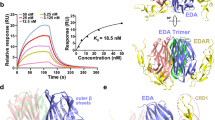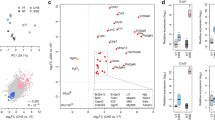Abstract
Ectodermal-dysplasia-syndactyly syndrome (EDSS1) is a rare form of ectodermal dysplasia (ED), affecting skin and its appendages mainly hair, teeth and nails. In the present study, we have investigated a large consanguineous Pakistani family with 10 individuals showing features of EDSS1. Human genome was screened using highly polymorphic microsatellite markers to identify the gene causing EDSS1. The disease locus for EDSS1 was assigned to chromosome 1q23.1-q23.3. This region corresponds to 5.63 Mb according to the sequenced based physical map (Build 36.2) of the human genome and flanked by markers D1S1653 and D1S1677. A maximum two-point LOD score of 5.05 was obtained with the marker D1S484. Sequence analysis revealed a homozygous missense mutation (c.635C>G; p.Pro212Arg) in the recently reported PVRL4 gene causing EDSS1. The involvement of mutant nectin-4 in causing EDSS1 may open up interesting prospectives into the role of cell adhesion molecules in causing syndromic forms of EDs.
Similar content being viewed by others
Log in or create a free account to read this content
Gain free access to this article, as well as selected content from this journal and more on nature.com
or
References
Tariq, M., Khan, M. N. & Ahmad, W. Ectodermal dysplasia-cutaneous syndactyly syndrome maps to chromosome 7p21.1-p14.3. Hum. Genet. 125, 421–429 (2009).
Boudghene-Stambouli, O. & Merad-Boudia, A. Association of ectodermal dysplasia and syndactylia. Ann. Dermatol. Venereol. 118, 107–110 (1991).
Freire-Maia, N. & Pinheiro, M. Ectodermal dysplasias: a clinical and genetic study. Alan. R. Liss. New York 172–173 (1984).
Brancati, F., Fortugno, P., Bottillo, I., Lopez, M., Josselin, E., Boudghene-Stambouli, O. et al. Mutations in PVRL4, encoding cell adhesion molecule nectin-4, cause ectodermal dysplasia-syndactyly syndrome. Am. J. Hum. Genet. 87, 265–273 (2010).
Sobel, E. & Lange, K. Descent graphs in pedigree analysis: applications to haplotyping, location scores, and marker-sharing statistics. Am. J. Hum. Genet. 58, 1323–1337 (1996).
Wigginton, J. E. & Abecasis, G. R. PEDSTATS: descriptive statistics, graphics and quality assessment for gene mapping data. Bioinformatics 21, 3445–3447 (2005).
Cottingham##Jr, R. W., Idury, R. M. & Schaffer, A. A. Faster sequential genetic linkage computations. Am. J. Hum. Genet. 53, 252–263 (1993).
Matise, T. C., Chen, F., Chen, W., De-La-Vega, F. M., Hansen, M., He, C. et al. A second-generation combined linkage physical map of the human genome. Genome Res. 17, 1783–1786 (2007).
Rozen, S. & Skaletsky, H. Primer3 on the WWW for general users and for biologist programmers. Methods Mol. Biol. 132, 365–386 (2000).
Reymond, N., Fabre, S., Lecocq, E., Adelaide, J., Dubreuil, P. & Lopez, M. Nectin4/PRR4, a new Afadin-associated member of the nectin family that trans-interacts with nectin1/PRR1 through V domain interaction. J. Biol. Chem. 276, 43205–43215 (2001).
Perez-Moreno, M., Jamora, C. & Fuchs, E. Sticky business: orchestrating cellular signals at adherens junctions. Cell 112, 535–548 (2003).
Suzuki, K., Hu, D., Bustos, T., Zlotogora, J., Richieri-Costa, A., Helms, J. A. et al. Mutations of PVRL1, encoding a cell-cell adhesion molecule/herpesvirus receptor, in cleft lip/palate-ectodermal dysplasia. Nat. Genet. 25, 427–430 (2000).
Acknowledgements
We are grateful to all the members of the family for their invaluable participation and cooperation. Funding: the work presented here was funded by Higher Education Commission (HEC), Islamabad, Pakistan. Musharraf Jelani was supported by an indigenous PhD fellowship from HEC, Islamabad, Pakistan.
Author information
Authors and Affiliations
Corresponding author
Ethics declarations
Competing interests
The authors declare no conflict of interest.
Rights and permissions
About this article
Cite this article
Jelani, M., Chishti, M. & Ahmad, W. Mutation in PVRL4 gene encoding nectin-4 underlies ectodermal-dysplasia-syndactyly syndrome (EDSS1). J Hum Genet 56, 352–357 (2011). https://doi.org/10.1038/jhg.2011.18
Received:
Revised:
Accepted:
Published:
Issue date:
DOI: https://doi.org/10.1038/jhg.2011.18
Keywords
This article is cited by
-
The biology and rationale of targeting nectin-4 in urothelial carcinoma
Nature Reviews Urology (2021)
-
Chemovirotherapeutic Treatment Using Camptothecin Enhances Oncolytic Measles Virus-Mediated Killing of Breast Cancer Cells
Scientific Reports (2019)
-
Potential role for nectin-4 in the pathogenesis of pre-eclampsia: a molecular genetic study
BMC Medical Genetics (2018)
-
Epidermal cell junctions and their regulation by p63 in health and disease
Cell and Tissue Research (2015)
-
Nectin-4 Mutations Causing Ectodermal Dysplasia with Syndactyly Perturb the Rac1 Pathway and the Kinetics of Adherens Junction Formation
Journal of Investigative Dermatology (2014)



